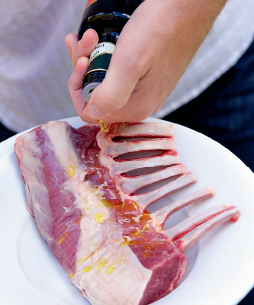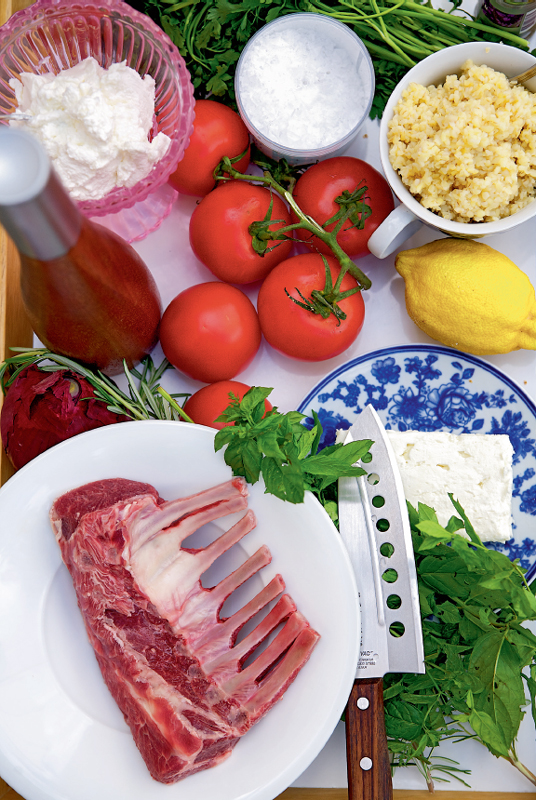Fat: Saturated or Unsaturated?
Fat is arguably the most important nutrient to consume in order to feel good and function properly. Fat builds our bodies because it’s included in our cell membranes. Fat also ensures that we can absorb the nutrients in fat-soluble vitamins and antioxidants. We also know that the body prefers to burn the nutrients that we feed it, so if you consume only low amounts of fat, your fat-burning process will suffer. A reasonable amount of fat will also make you feel full longer, keeping your faculties sharp and preventing weight gain. Basically, we have to consume the proper amounts and types of fat.
At the same time, you shouldn’t eat too much fat. It will make you gain weight. There are twice as many calories in fat as in carbohydrates and protein. A fat intake that is too high will cause inflammations in your body, because it will stimulate the uptake of endotoxins in your intestines. Endotoxins are toxins that are produced by bacteria in the intestines and are fat-soluble, which causes the level of endotoxins in your blood to increase by as much as 50 percent. This generates inflammation and is harmful to your health. Balance is the key word here, which is exactly what LCHQ provides. 40 E% of fat is not much more than the average person consumes, so you may not have to make any significant change to your daily fat consumption. However, you should keep an eye on the quality of the fats consumed, because this is key in order for the fats to function properly.
LCHQ and the quality of the fat
Food contains saturated, monounsaturated, and polyunsaturated fat. Each has a special function and you shouldn’t be afraid of any of them. However, research has shown that there is a certain fat composition that is optimal for humans. It basically focuses on monounsaturated fat, which protects you from cardiovascular disease and type 2 diabetes, as well as many forms of cancer. Good sources of monounsaturated fat are olive oil, avocado, nuts, and canola oil, to name a few. In fact, most sources of fat contain monounsaturated fat.
Polyunsaturated fat is also good for your cardiovascular health and can be derived from plant sources, such as seeds, grains, oats, and legumes, as well as from fish and seafood. Even some nuts have a relatively high content of polyunsaturated fat. It’s also this fat, along with short and medium-long saturated fats, that the body is best able to process.
The short and medium-long saturated fats can be found in dairy products and coconut oil, and are included in the LCHQ diet. Research has actually shown that these are great for maintaining your weight and overall health, and they are also stable, which means that they don’t suffer the risk of going rancid in your body.
LCHQ vs LCHF
A couple of years ago, the Swedish diet Low Carb High Fat (LCHF) started gaining national attention. In simple terms, LCHF is one of the most extreme diets that has ever existed. It basically restricts your intake of carbohydrates to 5–10 E% per day and replaces the lost carbs with large quantities of fat. Bacon, lard, cream, and butter were staples for this diet—and I consciously chose the past tense because LCHF has since become less strict and more varied in recent years. Today, some LCHF proponents recommend that you eat fruit, berries, and other fats in addition to the saturated fats, which I find to be a beneficial and healthy development. Many recent LCHF cookbooks contain some great recipes. I’m not critical of today’s more commercial interpretation of LCHF, which is sometimes referred to as “liberal LCHF.”
I am, however, very critical of the original form of LCHF. Strict LCHF (I’ll call it “classic LCHF”) is based on saturated animal fat, which has proven to be very unhealthy in myriad ways. An important thing to note here is that not all types of saturated fat were created equal. They exist in different forms, and research has shown that the short and medium saturated fats are good for your weight and your overall health. Many studies also show that they serve to improve your ability to burn fat and expend energy while also maintaining your weight (33–42). Short and medium saturated fats constitute about 60 to 70 percent of the fat in coconut and palm oil, 25 percent of the fat in dairy, and it is commonly found in breast milk. It’s the long-chain saturated fats found in lard and fatty meat products that cause such health issues as type 2 diabetes and cardiovascular disease (66).
When I refer to LCHF in this book, I mean the extreme form that recommends a minimal intake of carbs and an extreme consumption of long-chain saturated fat. I am fully aware that there are healthier versions of LCHF (“liberal LCHF”), and I have nothing against them, although I do believe that LCHQ is the best option for most people.
Here is the scientific understanding of LCHQ and classic LCHF:
 The quality of fat in LCHQ is beneficial for reducing oxidative stress. After each meal, the free radicals in your body increase and LCHQ, with its high content of monounsaturated fat, trumps that of LCHF. One study showed that people who consumed monounsaturated fat for twelve weeks had less oxidized fat in their bodies than those who consumed long-chain saturated fat (1).
The quality of fat in LCHQ is beneficial for reducing oxidative stress. After each meal, the free radicals in your body increase and LCHQ, with its high content of monounsaturated fat, trumps that of LCHF. One study showed that people who consumed monounsaturated fat for twelve weeks had less oxidized fat in their bodies than those who consumed long-chain saturated fat (1).
 You will probably live longer if you eat LCHQ rather than classic LCHF. A very large study (of approximately 130,000 people) showed that a low-carb diet that was based on animal products resulted in a shorter life expectancy than a low-carb diet combined with vegetable foodstuffs. Following the animal product-based diet results in a much higher consumption of long-chain saturated fats, while the vegetable-based diet results in the consumption of more unsaturated fats. The overall mortality rate increased, regardless of whether you examined cancer, cardiovascular disease, strokes, or other diseases (2). LCHQ encourages the consumption of many more vegetables, which provide much more than just the healthy fats. Vegetables also contain more antioxidants, phytonutrients, and fibers.
You will probably live longer if you eat LCHQ rather than classic LCHF. A very large study (of approximately 130,000 people) showed that a low-carb diet that was based on animal products resulted in a shorter life expectancy than a low-carb diet combined with vegetable foodstuffs. Following the animal product-based diet results in a much higher consumption of long-chain saturated fats, while the vegetable-based diet results in the consumption of more unsaturated fats. The overall mortality rate increased, regardless of whether you examined cancer, cardiovascular disease, strokes, or other diseases (2). LCHQ encourages the consumption of many more vegetables, which provide much more than just the healthy fats. Vegetables also contain more antioxidants, phytonutrients, and fibers.
 Your heart also benefits more from LCHQ than from LCHF. If you study the research, it’s evident that reducing the consumption of long-chain saturated fat in favor of unsaturated fat reduced the risk of cardiovascular disease (3). You can experience dramatic effects if you increase your healthy fat consumption by an ounce (28.35 g) of nuts and exclude the equivalent amount of calories of saturated fats (which is a typical effect of LCHQ). This decreases the risk for cardiovascular disease by 45 percent (4)! Research also shows that too high an intake of fat (regardless of quality) reduces the amount of available energy for the heart muscle, resulting in a very dangerous situation for people suffering from heart failure (46).
Your heart also benefits more from LCHQ than from LCHF. If you study the research, it’s evident that reducing the consumption of long-chain saturated fat in favor of unsaturated fat reduced the risk of cardiovascular disease (3). You can experience dramatic effects if you increase your healthy fat consumption by an ounce (28.35 g) of nuts and exclude the equivalent amount of calories of saturated fats (which is a typical effect of LCHQ). This decreases the risk for cardiovascular disease by 45 percent (4)! Research also shows that too high an intake of fat (regardless of quality) reduces the amount of available energy for the heart muscle, resulting in a very dangerous situation for people suffering from heart failure (46).
 Pertaining to the risk of cancer, research shows that saturated fat increases the risk of breast cancer (5, 6), ovarian cancer (7), and lymphoma (8). Personally, I think that studies that point to a certain type of nutrient as the cause of disease sometimes suggest that the root of the problem is actually a low intake of other nutrients. A high intake of saturated fat is almost always an automatic indicator of a low intake of omega-3 and omega-9 fats, which seem to reduce the risk of cancer.
Pertaining to the risk of cancer, research shows that saturated fat increases the risk of breast cancer (5, 6), ovarian cancer (7), and lymphoma (8). Personally, I think that studies that point to a certain type of nutrient as the cause of disease sometimes suggest that the root of the problem is actually a low intake of other nutrients. A high intake of saturated fat is almost always an automatic indicator of a low intake of omega-3 and omega-9 fats, which seem to reduce the risk of cancer.
Therefore, I don’t think that a reasonable consumption of long-chain saturated fat is dangerous in this regard, but it does push out other necessary fats. And this is exactly what happens with LCHF, since the high intake of long-chain saturated fat leads to a very one-sided and unhealthy diet.
 You will lose weight much faster and more effectively if you skip long-chain saturated fats in favor of the unsaturated fat advocated in LCHQ. One study showed that LCHQ, with more unsaturated fat from fish, seafood, and chicken, generated 1.1 lbs (.5 kg) more weight lost during a four-week period, compared to an LCHF diet consisting of fat from livestock that had been fattened with concentrates (9). Generally speaking, long-chain saturated fat is the most fattening thing that exists, except for synthetic trans fats.
You will lose weight much faster and more effectively if you skip long-chain saturated fats in favor of the unsaturated fat advocated in LCHQ. One study showed that LCHQ, with more unsaturated fat from fish, seafood, and chicken, generated 1.1 lbs (.5 kg) more weight lost during a four-week period, compared to an LCHF diet consisting of fat from livestock that had been fattened with concentrates (9). Generally speaking, long-chain saturated fat is the most fattening thing that exists, except for synthetic trans fats.
 Your brain is healthier when you consume reasonable amounts of fat and carbohydrates. Research shows that a diet with 75 E% fat causes a diminished attention span and mood, and makes your thought process slower compared to a diet of 23 E% fat (46). Another study shows that weight loss through LCHF results in aggression and hostility toward one’s environment (47). Based on my personal experience, I can testify to how a lack of carbs affects one’s mood, and I have run into several angry LCHF proponents over the years. This same research shows that LCHF users become more and more depressed while adhering to the diet, which is problematic because life is too short to be unhappy.
Your brain is healthier when you consume reasonable amounts of fat and carbohydrates. Research shows that a diet with 75 E% fat causes a diminished attention span and mood, and makes your thought process slower compared to a diet of 23 E% fat (46). Another study shows that weight loss through LCHF results in aggression and hostility toward one’s environment (47). Based on my personal experience, I can testify to how a lack of carbs affects one’s mood, and I have run into several angry LCHF proponents over the years. This same research shows that LCHF users become more and more depressed while adhering to the diet, which is problematic because life is too short to be unhappy.
 LCHF with low levels of carbs and a lot of animal fat increases the risk for type 2 diabetes, whereas LCHQ, with low levels of carbs and much higher levels of vegetable fat, prevents it (47).
LCHF with low levels of carbs and a lot of animal fat increases the risk for type 2 diabetes, whereas LCHQ, with low levels of carbs and much higher levels of vegetable fat, prevents it (47).
“An important thing to note here is that not all types of saturated fat were created equal.”

“If the color of your food has changed due to heat, you’ve created unhealthy types of fat.”
Free from trans fats
Trans fats have a proven harmful effect on your heart and blood vessels. It also affects growth in children, and lowers infant birth weight if consumed while pregnant. It also increases the risk for cancer and makes inflammations more aggressive; this all adds up to mean that trans fats are one of few components in food that you should avoid at all costs. Luckily, most countries have placed a restriction on the level of trans fats that food is allowed to contain, and some states and cities in the United States have actively banned trans fats. However, imported products from other countries may not adhere to these standards. Trans fats can also arise from cooking your food.
Because trans fats are created from fat being heated up or industrially cured, they’re pretty simple to avoid. One method is to simply cook food at reasonable temperatures. Avoid deep frying anything, and avoid creating a fried surface on your food. If the color of your food has changed due to heat, you’ve created unhealthy types of fat and destroyed the carbohydrates and proteins, which will negatively affect your health. Generally speaking, frying should occur at low temperatures and with fats that can withstand heat, such as olive oil, avocado oil, or better yet, coconut oil.
The food industry has enjoyed putting trans fats in all types of products, because trans fats are inexpensive to produce and long-lasting. Trans fats give cheaply-made food a better taste and texture. Unfortunately, it’s not always easy to detect “trans fat” on the nutritional label, since it doesn’t always go by that name. It’s often indicated by the phrase “partially hydrogenated oils,” which could, for example, be canola oil that has been exposed to high temperatures, hydrogen gas, and a catalyst such as nickel. This process saturates the fatty acids, and eventually, the oil will consist solely of saturated fat and will be basically useless because it has been so completely hardened. Therefore, the hardening process is halted after a while, resulting in a fat that is semi-liquid, durable, and contains lethal trans fats.
Thankfully, many companies have eliminated trans fats from their products. However, they still often show up in finished goods, candy, pastries, snacks, frying oils, etc. This is why you should avoid products that include “partially hydrogenated oil,” “hydrogenated fat,” “partially hydrogenated fat,” or “hardened oil.” Sometimes it says “hardened” instead of hydrogenated, but it’s the same thing. When you eat LCHQ, your food should generally be of a high quality, which automatically excludes trans fats.


 The quality of fat in LCHQ is beneficial for reducing oxidative stress. After each meal, the free radicals in your body increase and LCHQ, with its high content of monounsaturated fat, trumps that of LCHF. One study showed that people who consumed monounsaturated fat for twelve weeks had less oxidized fat in their bodies than those who consumed long-chain saturated fat (1).
The quality of fat in LCHQ is beneficial for reducing oxidative stress. After each meal, the free radicals in your body increase and LCHQ, with its high content of monounsaturated fat, trumps that of LCHF. One study showed that people who consumed monounsaturated fat for twelve weeks had less oxidized fat in their bodies than those who consumed long-chain saturated fat (1).

